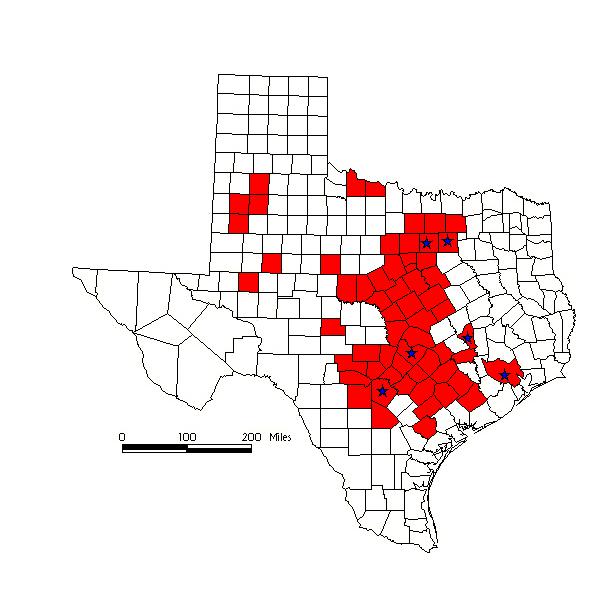Oak wilt is an fungal parasite that affects the vascular system of an oak tree. On June 18-19, 2014, Dr. David Appel and Jim Houser of the Texas A&M Forest Department updated ISA Certified Arborists, including Shane Kelly of Canopy Tree Service on the latest treatment techniques.
Arborists care about treating oak wilt. This parasite can wipe out the majority of oak trees in an area if allowed to become established. This parasite lives in and feeds off the portion of the tree known as the xylem. The xylem are layers of sieve tubes that move nutrients around the tree. They do this by negative pressure caused by water evapo-transpiring through tiny leaf openings known as stomatas. The presence of the this disease prevents the tree from receiving needed water. So it “wilts.”

Oak Wilt: a Tree’s Slow Demise
The fungus doesn’t always kill the oak tree directly or instantly. At first the presence of the disease isn’t recognized or responded to right away, especially in red oaks. Instead, the disease is allowed to spread. Finally, a late-stage protective response is initiated. This response kills the tree. How? The oak tree seals off compartments and attempts to regrow around the diseased areas. In the process, healthy tree tissue is deprived of needed nutrients. The late recognition and response to the oak wilt blocks off more sieve tubes crucial to the process of transpiration, lowering the tree’s chance of survival.
White oaks fair better than red oaks. Why? Unlike the red oaks, the white oaks actually recognize and respond to the presence of oak wilt while it is a small problem. The fewer sieve tubes that are shut down in an early response to fungus the more likely the tree will survive.
Oak Wilt Aerial Spread with Red Oaks
Oak wilt spreads in two main ways: aerial and root grafting. Arial spread of oak wilt occurs mainly in red oaks. The fungus creates a fungal mat. Fungal mats are how spores are released to affect other trees where spores are released and carried by insects. Fungal mats are only dangerous when a Red Oak dies during the cooler months.
The nitidulid, a hairy beetle, presents a particular problem. It is attracted to fungal spores, fresh tree wounds or any other source of vegetation. As the beetle travels to the next tree, it picks up spores from the mat and transfers them. Temperature greatly affects the transfer of aerial oak wilt. The spores cannot survive above 95 degrees or below 45 degrees. If fresh cuts are painted, the scent of a recently cut oak tree is blocked, preventing the nitidulid from locating its next meal.
Root Systems Spread Fungus in Live Oaks
Trees in clusters have root systems that intertwine. Oak wilt spreads about 75 feet per year through live oaks’ roots. To prevent this disease from affecting live oaks in rural areas and ranch land, it is best to dig a four-foot trench around the tree, about 100 feet from the infected area’s edge. Trenching can be a valuable solution in these situations, requiring cooperation from all neighbors. To kill the trees within the trenched area quickly, they should be pushed down. Afterwards, another fungus called “Hypoxylon Canker” is more effective in consuming the trees.
City Solution
Trenching becomes impractical in towns or small lots with many utilities. Skilled arborists can address this disease through tree injections. They inject a fungicide called Propiconazole using either macroinjection or microinjection methods. Although success rates are similar, one method may succeed while the other fails.
Oak wilt is a powerful parasite that can attack and kill the most vigorous oak trees. Interestingly, an oak that is already stressed and in defense mode may actually fare better when challenged by oak wilt.
Oak Wilt Spread Myths
Fire wood is often associated with the spread of oak wilt. In order for fire wood to spread it , it would have to be a red oak with fungal mats, or an infected tree immediately transferred to a susceptible root zone. Although oak wilt is a powerful parasite, it is no match for saprophytes such as Hypoxylon Canker that is found in all trees. Plus in the case of using fire wood to build a fire, the fire is usually hotter than 95 degrees and that kills the spores.
Tools are another method of transport blamed for spreading oak wilt. Blaming tools like shovels, picks, and backhoes for spreading the fungus is accurate. They work underground in the root zones and can possibly carry bits of infected root along for the ride if they collect chunks of mud. In contrast, gasoline and oil coating chainsaws make them unlikely spreaders since they produce heat way beyond the temperature spores can tolerate and cannot establish oak wilt on the bare metal surface.
Best Time to Identify Oak Wilt
The best months to identify oak wilt are May and June in San Antonio. A Canopy Tree Service Certified Arborist will take samples of the tree and put it into a zip lock bag with blue ice and deliver it to Texas A&M lab for analysis.
Oak Wilt has affected trees in 74 counties in Texas and the list is growing. For information on its spread, check out the article with the Texas A&M Forest Service If you suspect you have oak wilt, call Canopy Tree Service for an evaluation.